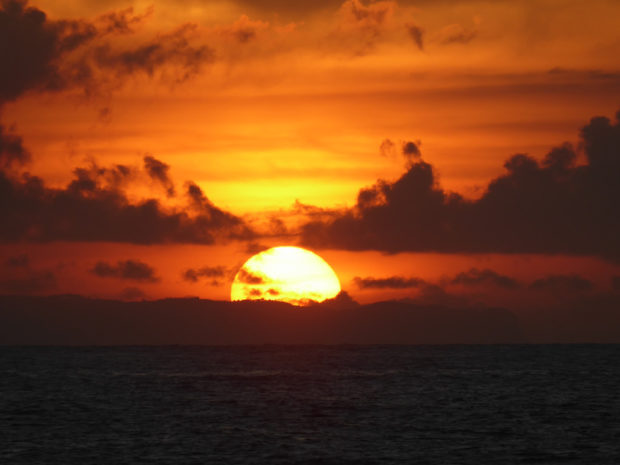You have no items in your cart. Want to get some nice things?
Go shopping
We had lunch at Gunung Sari (Sari means the essential part of the flower – the pistil?). There, we decided to go over to Trunyan, the village of the Bali Aga, the native people of the island. Dewa, our guide, and others had told us that it was very poor and that begging could get aggressive. We had to acquire another guide, however, to charter a boat and lead us to the people. This was not something Dewa felt he could do.
Dewa asked one of the waiters who said he had a friend who could lead us. He left and soon came back with his friend, tattoos on the wrist, a big smile. He and the waiter, a slight, gentle young man with long hair and a smooth youthful face, were both named Nyoman. We set a price and Nyoman One, the older one who had a personality of one who does things well, efficiently, but who always has one eye set on the next move, directed us in the car to the boat dock below.
Children, young women came with more bracelets to sell, but we were running low on money. Nyoman One actually filled out a receipt for me, saying the money we gave him would lower the trip and the cost of offerings at the village.
We crossed the waters in the small narrow boat. Mount Batur rose up on our left, across the waters, mist floating around the base, sun halos around its summit. On our right were the old hollowed inner walls of the mountain, nearly double the dimension of the newer, inner cone. The water was a rich, emerald green, and our little boat with its wooden roof and slats for seats chugged loudly towards the village.
The village sits at the base of Mount Abang, which is really what remains of the old volcano, across the water from Mount Batur. A series of one-story huts with tiled rooftops, the village is stacked on a steep hillside with little room for agriculture. Onions are about all that they grow there, Dewa told us.
We arrived at the village, and children were swimming in the water around the docks. I could not see a dramatic physical difference between them and the rest of the Balinese people. We climbed out of the boat and entered the village. It was poor, with crowded, meagerly furnished houses, one shop where they sold water, sodas and cigarettes. About five hundred meters from the water was the temple.
I followed Dewa’s moves. Whatever he did or indicated to do I would do, otherwise I would say or do nothing. He spoke to one of the Bali Aga men and then told me that we did not need to wear a Sarong to enter the temple, called Pura Pansering Jagat. I hesitated a moment. Neal hung back. Nyoman One and Nyoman Two talked with a few other men. I stepped toward the temple. In the entrance they had placed a 100,000 and a 50,000 RP. note and covered them with a stone. One of them smiled and pointed at the money, showing that this was how much they wanted to enter the temple. I didn’t really want to enter anyway, but there was now this odd push – we had arrived, there was really nowhere else to go, and it seemed expected that we should enter the temple. I took out a few $1,000 notes and bent down to place them next to the other money, but a man sitting by the entrance shook his head as if to say this was not enough. I stepped away, then, saying “It’s all I have,” and began to walk away from the entrance. But several of the men moved forward, smiling, and Dewa translated that they were saying it was all right to give what I had, so I placed the money under the stone and we all went into the temple.
Now the air was light, friendly. One of the villagers, his name also Nyoman, came over, and he told us the story of the temple. He said that beneath the eight-tier shrine was a stone called Arca da Tonta Ratu Gede Pusering Jagat, and that this stone would appear out of the ground on the night of the Purnamaning Sasih Kapat ceremony, sometime around early October. Otherwise, he said, you could not see the stone. He also said that they had a sacred manuscript, or Lontar, carved into a sacred root, but it was in a language that no one could read. It resembled Arabic, but it was not recognisable. Their village, Nyoman said, was the key to the island and the location of the island’s power, and no earthquake had ever hit it.
We thanked Nyoman for speaking with us and I gave him a few thousand Rupiah. I also saw Nyoman Two give him some money. We then left the temple and went back to the boat.
Our next stop was Kuban, the cemetery. The question I have for myself now is, why did we go? I made sure to express to Nyoman and Dewa, before we left, that we did not want to show any disrespect, that in western cultures it is not uncommon to visit cemeteries – in England, in France, America. What is behind our fascination for these places? Morbidity? A reminder of our mortality? An attempt to glimpse something just beyond our sight, the mysterious beyond? I can’t say, but as part of our journey to Trunyan we also paid a visit to their cemetery.
In Kuban, they do not bury the dead. They are laid upon the ground and covered with a triangular tent-like structure. The people of the village conduct a symbolic cremation, meant to aid the spirit’s release from the body and journey to heaven, but unlike most of the Balinese, they do not actually cremate the dead.
We arrived in Kuban and climbed a short path to the cemetery. To the right was a wall of several tiers, and along one tier was a row of skulls and one that looked like a Barong mask, but I could be wrong about that. To the back of the hillside were six or seven gravesites. One was fairly new, with a yellow umbrella over it and green banana leaf weavings. To the left was a pile of old wicker coverings, clothes, and, as I slowly realised only after several minutes, scattered bones and skulls of the dead. The smell was strong, and I did not go too close to the gravesites. A man came up and spoke to us briefly, describing the burial process, or mepasah, in some detail. I felt rather eager to leave, actually. I don’t know if it was the smell or what, but I felt a little dizzy there. In fact, my head swam as though the place were weighted or overheated with the long slow energy of decay. But the man lingered and I did not want to be rude. By now the others, except for Dewa, had moved back down to the beach, but as long as the man remained, I remained, smelling the dead, feeling the proximity of the dead, looking down at the scrap-heap of their bones. The man lit a clove cigarette, and the smell of it only added a sweet overcast to the already gloomy atmosphere.
As we started to leave, the man asked me for money, but I had put my last $10,000 rupiah into the offering pot at the gravesite. I only had an American dollar and I gave him that. He seemed a bit annoyed and asked the others if they could change it to rupiah for him. Our boat driver, a young man who I think was from the village, threw a stone at the man and called out something, an insult of some kind, and I suspected that the young man did not want the other man honing in on their prospects for money, or out of pride he didn’t want this other man begging from us… who knows. So much of it seemed obvious, yet some unfamiliar code or custom could have been at work here.
We climbed back into the boat and headed back to the docks below Kintamani. I offered both Nymonas a cigarette and smoked one of my own. The sun was settling behind Mount Batur, Dewi Danu, goddess of water. I dipped my hand into the water and touched my head to cleanse it.

About Douglas Cole
Douglas Cole has published four collections of poetry. His work appears in journals such as The Chicago Quarterly Review, Chiron, The Galway Review, The Pinyon Review, Solstice, Eastern Iowa Review, Kentucky Review, Wisconsin Review, and Slipstream. He has been nominated for a Pushcart and Best of the Net, and has received the Leslie Hunt Memorial Prize in Poetry; the Best of Poetry Award from Clapboard House; First Prize in the “Picture Worth 500 Words” from Tattoo Highway. His website is douglastcole.com.



